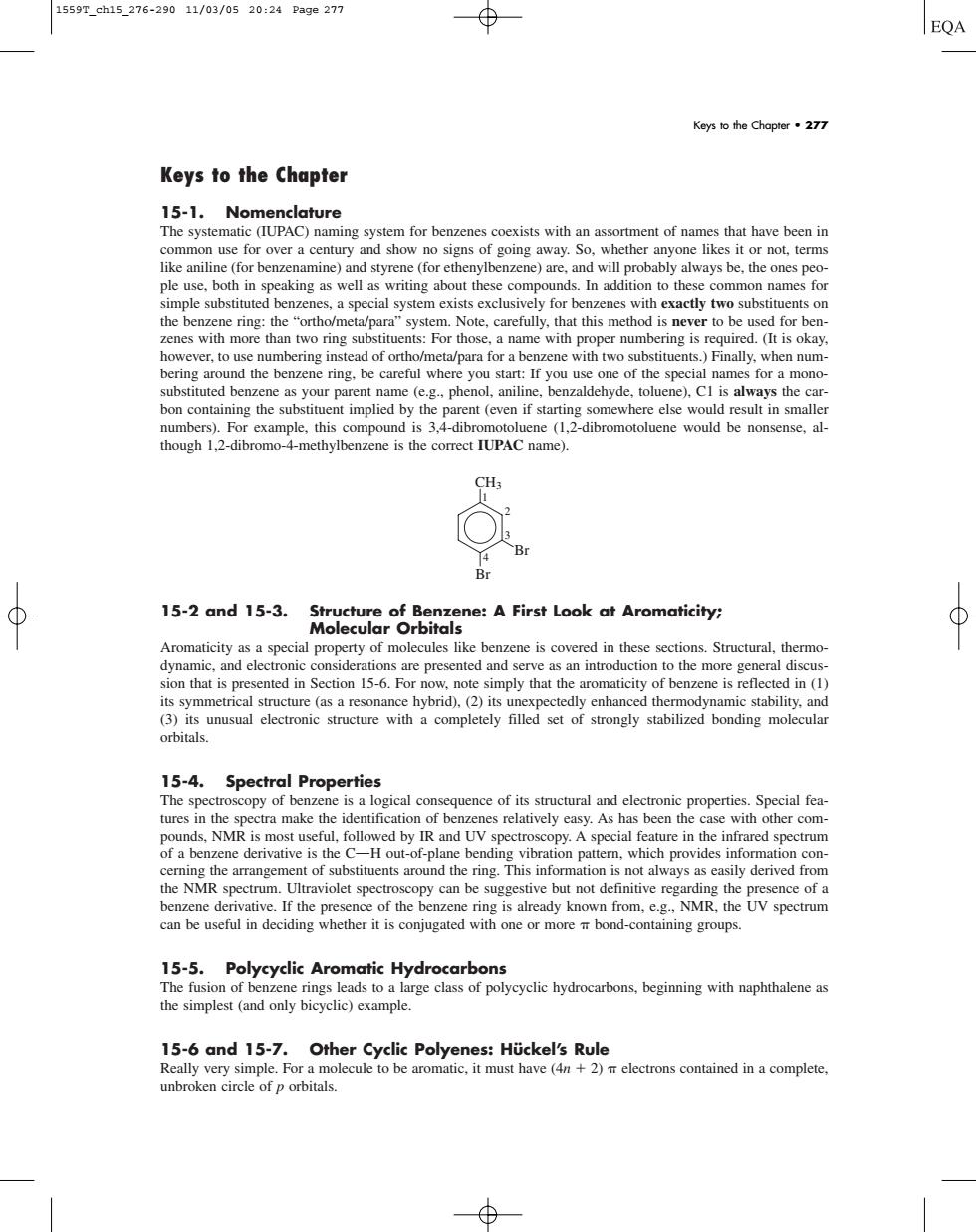正在加载图片...

15597.ch15276-29011/02/0520:24Page277 EQA Keys o the Chapter·277 Keys to the Chapter ing system for benzenes coexists with an assortment of names that have been in for over a century and show no signs of goingay anyone likes it or no terms e namine)an styrene (o ethenylbenzene)ar always be.the ones peo however.to use numbering instead of ortho/meta/para for a benzene with two substituents.)Finally.when num bering around the benzene ring,be careful where you start:If you use one of the special names for a mono sult in numbers)For xample this compound is.4-dibromotoluene(1-dibromotoluene would be nonsense though 1.2-dibromo-4-methylbenzene is the correct IUPAC name). CHs B Br 15-2and15-3. Aromaticity as a special property of molecules like benzene is covered in these sections.Structural,thermo dynamic.and ele consid ctedly enhanced ther seletocrwitha complctly filld st of srongy stabilized bonding moec (3)i1 15-4.Spectral Properties opy or ber pounds NMR is most useful.followed by IR and Uv spectroscopy.A special fearure in the infrared spectrum ben the NMR spectrum.Ultraviolet spectrose opy can be suggestive but not definitive regarding the presence of a e of the b ing w her:。:e12hg5C0w0F one or more bor 15-5.Polycyclic atic Hydrocarb on clic Pe unbroken circle of p orbitals.Keys to the Chapter 15-1. Nomenclature The systematic (IUPAC) naming system for benzenes coexists with an assortment of names that have been in common use for over a century and show no signs of going away. So, whether anyone likes it or not, terms like aniline (for benzenamine) and styrene (for ethenylbenzene) are, and will probably always be, the ones people use, both in speaking as well as writing about these compounds. In addition to these common names for simple substituted benzenes, a special system exists exclusively for benzenes with exactly two substituents on the benzene ring: the “ortho/meta/para” system. Note, carefully, that this method is never to be used for benzenes with more than two ring substituents: For those, a name with proper numbering is required. (It is okay, however, to use numbering instead of ortho/meta/para for a benzene with two substituents.) Finally, when numbering around the benzene ring, be careful where you start: If you use one of the special names for a monosubstituted benzene as your parent name (e.g., phenol, aniline, benzaldehyde, toluene), C1 is always the carbon containing the substituent implied by the parent (even if starting somewhere else would result in smaller numbers). For example, this compound is 3,4-dibromotoluene (1,2-dibromotoluene would be nonsense, although 1,2-dibromo-4-methylbenzene is the correct IUPAC name). 15-2 and 15-3. Structure of Benzene: A First Look at Aromaticity; Molecular Orbitals Aromaticity as a special property of molecules like benzene is covered in these sections. Structural, thermodynamic, and electronic considerations are presented and serve as an introduction to the more general discussion that is presented in Section 15-6. For now, note simply that the aromaticity of benzene is reflected in (1) its symmetrical structure (as a resonance hybrid), (2) its unexpectedly enhanced thermodynamic stability, and (3) its unusual electronic structure with a completely filled set of strongly stabilized bonding molecular orbitals. 15-4. Spectral Properties The spectroscopy of benzene is a logical consequence of its structural and electronic properties. Special features in the spectra make the identification of benzenes relatively easy. As has been the case with other compounds, NMR is most useful, followed by IR and UV spectroscopy. A special feature in the infrared spectrum of a benzene derivative is the COH out-of-plane bending vibration pattern, which provides information concerning the arrangement of substituents around the ring. This information is not always as easily derived from the NMR spectrum. Ultraviolet spectroscopy can be suggestive but not definitive regarding the presence of a benzene derivative. If the presence of the benzene ring is already known from, e.g., NMR, the UV spectrum can be useful in deciding whether it is conjugated with one or more bond-containing groups. 15-5. Polycyclic Aromatic Hydrocarbons The fusion of benzene rings leads to a large class of polycyclic hydrocarbons, beginning with naphthalene as the simplest (and only bicyclic) example. 15-6 and 15-7. Other Cyclic Polyenes: Hückel’s Rule Really very simple. For a molecule to be aromatic, it must have (4n 2) electrons contained in a complete, unbroken circle of p orbitals. CH3 Br Br 1 2 3 4 Keys to the Chapter • 277 1559T_ch15_276-290 11/03/05 20:24 Page 277�